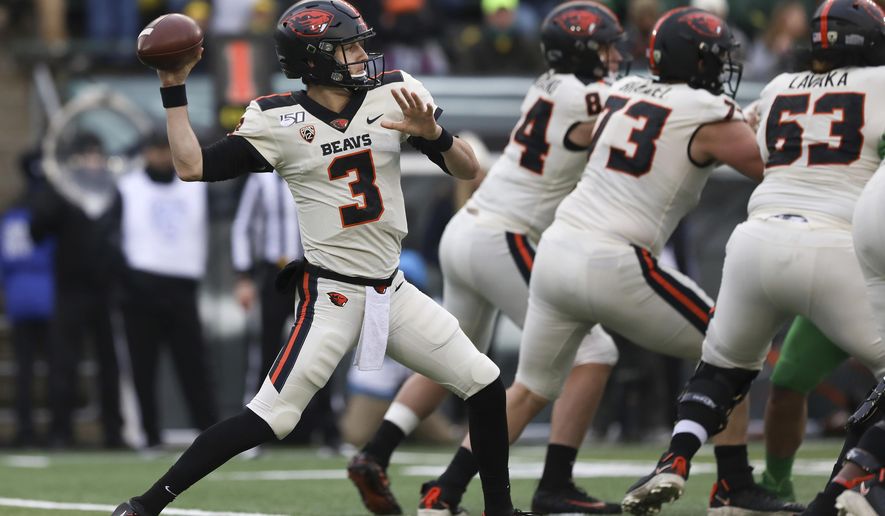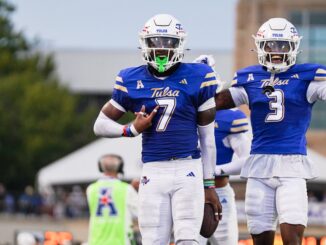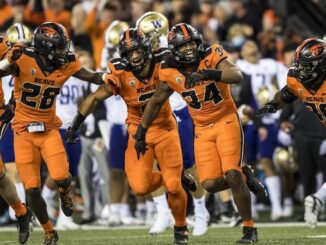
PAC-12 football is finally here and that makes this a good time to take a look at the intriguing matchup of Washington State at Oregon State.
The game is scheduled to begin at 7:30pm on Saturday and will be televised by FS1.
What makes this game intriguing is the uncertainty of what to expect from Washington State’s new head coach Nick Rolovich plus some prior disputes between him and Oregon State coach Jonathan Smith.
Let’s take a look at how these teams match up in terms of returning producers and how the teams played last year.
Quarterbacks [small advantage OSU]
Both teams are starting over at quarterback.
Washington State will start Cammon Cooper. Although he has been in the WSU system for three years, he has yet to take a snap.
Nonetheless, he was a four-star recruit and received high praise last week when coach Rolovich commented, “I thought he was consistent, I thought he was in command and I thought he knew where to go with the ball. I thought he could have gotten the ball out quicker, but for the opportunities he was given he did well.”
Coach R isn’t at all shy about pulling his starting qb and giving meaningful playing time to backups so I expect to see talented freshman Jayden de Laura.
Oregon State has to replace its starting quarterback as well. Tristan Gebbia, meanwhile, has played. In his 60 snaps last year, Gebbia completed better than 63% of his passes with a better-than-average 1.6% interception rate (2.2% is about average). He also ran the football for more than four yards per carry.
Until Cooper proves otherwise, Oregon State appears to have a slight advantage at the quarterback position.
Receivers [big advantage WSU]
Even a good quarterback can look bad if he doesn’t have effective receivers and Washington State has plenty of those.
In my preseason study of all 130 teams, the Cougars ranked 32nd for returning effective playmakers at the receiving position while Oregon State ranked near 100.
The Cougars lost all three of their top receivers but they still have an astounding four receivers who combined for 229 receptions, 20 touchdowns, and at least 500 receiving yards each. Expect 5’8″ senior Renard Bell to lead the pack.
Of the Beavers’ top three receivers, only 5’5″, 141 pound Champ Flemmings returns so new faces will have to step up if Gebbia is going to have enough targets. Tyjon Lindsey will fill one spot and he’s looked good in Fall workouts and OSU will likely incorporate tight ends Teagan Quitoriano and Luke Musgrave more into the offense. Both have been effective in recent workouts
Washington State led the country in passing yardage last season while Rolovich’s prior team Hawai’i was fifth. Oregon State gave up over 400 yards to Hawai’i’s passing attack in 2019.
I think we can see where this is going.
Running backs [small advantage OSU]
Oregon State has the depth but Washington State has the star.
The Beavers lost Artavis Pierce but the next four leading ball carriers (which includes qb Gebbia) all return. Junior Jamar Jefferson posted over 2000 yards in his first two seasons with OSU and will get another 1000 this year if he stays healthy.
Washington State’s Max Borghi averaged better than six yards per carry in 2019 which tells us that when WSU needs to run, it will do it very well. The problem for Washington State is that the next best running back only contributed 111 yards.
Until WSU proves it has more depth and diversity, I see Oregon State having a slight edge.
Offensive line [big advantage WSU]
Oregon State returns only half as much returning effectiveness to its offensive line as does Washington State.
Not only does more line talent return to the Cougars, but it performed better than OSU’s line. The Cougars were 18% better in producing yards per play, 33% better in not yielding tackles for loss, and 45% better for not yielding sacks.
Defense [no advantage]
Both defenses gave up exactly the same yards per rush to opponents (4.34) but Washington State returns 86% of its effective tacklers while Oregon State only returns 69%.
OSU has a big advantage in bringing pressure. Last year, the Beavers were 24% better than WSU in getting stops in opponents’ backfields and in 2020, they return 27% more of that talent than WSU.
The secondaries look like a “push” right now.
Washington State fans hope that coach R is able to solve the Cougars terrible defensive issues that were so bad in 2019 that defensive coordinator Tracy Claeys resigned just one-third of the way through the season.
However, don’t expect miracles because under Rolovich, Hawai’i never had a season in which its defense held opponents under 31 points per game.
Since neither could keep the other under 50 points last year, then I don’t see a meaningful defensive advantage for either.
History
Oregon State and Washington State met last year in Corvallis in a game the Beavers won 54-53.
The Beavers also faced coach Rolovich in Hawai’i last September in another close game that Hawai’i won 31-28 by scoring the final 17 points. Ryan Meskell made a late-game field goal after missing four others.
Overall
Washington State has a clear advantage in the overall return of key performing players.
Still, Oregon State might equalize things with the effectiveness of its aggressive defense.
Rolovich and Washington State have some advantage in being the home team this season. Last year’s one point win by OSU had the Beavers at home, but this year, the game is on the road. The last time OSU played a Rolovich team on the road was at Hawai’i in that narrow loss.
In studying our system for predicting games, I think it is going to predict a Washington State win by about two touchdowns.
While there are plenty of unknowns coming into opening week, the one thing we can count on is that this game will be close and have tons of points.
After waiting so long for the PAC-12 to finally get playing, isn’t that just the kind of game we want?
If you’re looking for more commentary, rankings, and predictions on college football, please visit us here.




